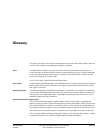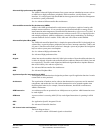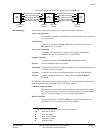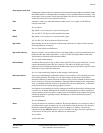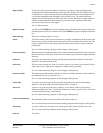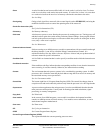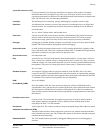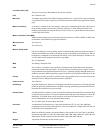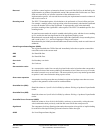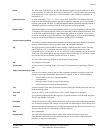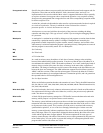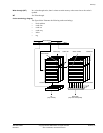
Glossary
ARM DDI 0363E Copyright © 2009 ARM Limited. All rights reserved. Glossary-10
ID013010 Non-Confidential, Unrestricted Access
Illegal instruction An instruction that is architecturally Undefined.
Implementation-defined
Means that the behavior is not architecturally defined, but should be defined and documented
by individual implementations.
Implementation-specific
Means that the behavior is not architecturally defined, and does not have to be documented by
individual implementations. Used when there are a number of implementation options available
and the option chosen does not affect software compatibility.
Infinity In the IEEE 754 standard format to represent infinity, the exponent is the maximum for the
precision and the fraction is all zeros.
Input exception An exception condition in which one or more of the operands for a given operation are not
supported by the hardware. The operation bounces to support code for processing.
Instruction cache A block of on-chip fast access memory locations, situated between the processor and main
memory, used for storing and retrieving copies of often used instructions. This is done to greatly
increase the average speed of memory accesses and so improve processor performance.
Instruction Synchronization Barrier (ISB)
An operation to ensure that the prefetch buffer is flushed of all out-of-date instructions.
Intermediate result An internal format used to store the result of a calculation before rounding. This format can have
a larger exponent field and fraction field than the destination format.
Interrupt handler A program to which control of the processor is passed when an interrupt occurs.
Interrupt vector One of a number of fixed addresses in low memory, or in high memory if high vectors are
configured, that contains the first instruction of the corresponding interrupt handler.
Invalidate To mark a cache line as being not valid by clearing the valid bit. This must be done whenever
the line does not contain a valid cache entry. For example, after a cache flush all lines are invalid.
ISB See Instruction Synchronization Barrier.
LE Little endian view of memory in both byte-invariant and word-invariant systems. See also
Byte-invariant, Word-invariant.
Line See Cache line.
Little-endian Byte ordering scheme in which bytes of increasing significance in a data word are stored at
increasing addresses in memory.
See also Big-endian and Endianness.
Little-endian memory
Memory in which:
• a byte or halfword at a word-aligned address is the least significant byte or halfword
within the word at that address
• a byte at a halfword-aligned address is the least significant byte within the halfword at that
address.
See also Big-endian memory.
Load/store architecture
A processor architecture where data-processing operations only operate on register contents, not
directly on memory contents.




